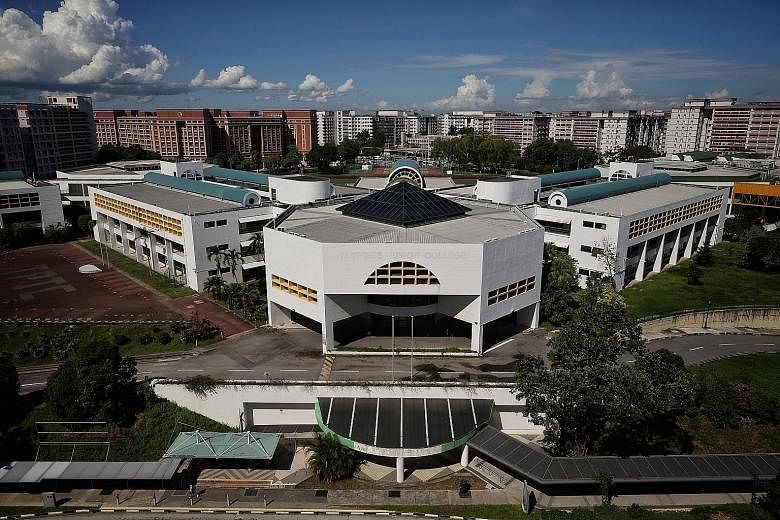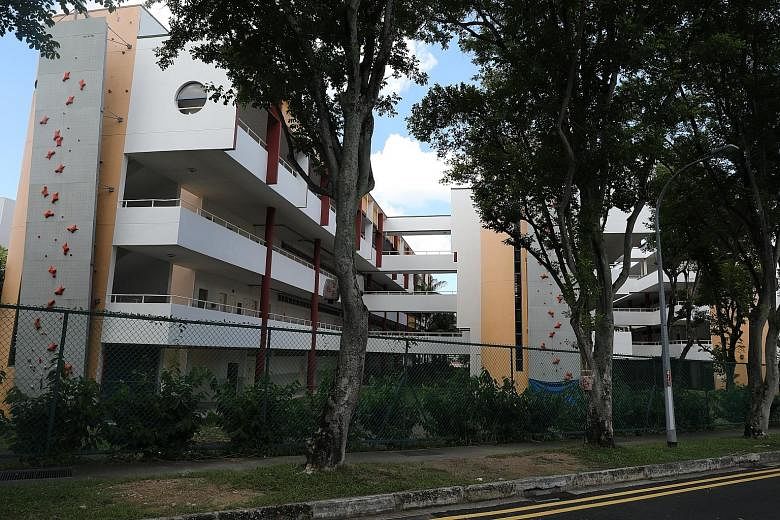At the former Serangoon Junior College campus, work has already started to turn the building from a school into a temporary home for migrant workers.
The facility in Upper Serangoon Road is one of 36 sites that have been earmarked to house healthy workers in the short to medium term to reduce crowding in dormitories amid the Covid-19 outbreak. Some of these sites are located in the middle of residential estates.
Workers at these places will go to work via transport arranged by their employers, and not be allowed to leave the premises on their days off. Instead, facilities such as minimarts, barber services and entertainment options will be set up at most sites.
The vast majority of coronavirus cases have been found among migrant workers in dormitories, prompting calls to relook these workers' living conditions.
Senior Minister of State for Culture, Community and Youth Sim Ann, an MP for Holland-Bukit Timah GRC, said yesterday it would be prudent for temporary migrant worker housing sites to remain self-contained until an effective vaccine arrives, "for the same reason that we minimise contact between households".
Several blocks along Kismis Avenue in her Bukit Timah ward have been converted into temporary migrant worker accommodations.
MPs interviewed said most residents understand the reasons for this move, adding that steps have been taken to minimise contact between workers and the general public in the interest of public health.
But some residents fear that security or cleanliness in their neighbourhoods may be affected by migrant workers moving in.
Senior Parliamentary Secretary for Culture, Community and Youth Baey Yam Keng said he hopes residents will not have the "not in my backyard" mindset towards the workers. In 2009, Serangoon Gardens residents objected vociferously to plans to build a foreign workers' dormitory there.
Hougang MP Png Eng Huat noted that workers housed in the Serangoon JC site will observe safe distancing measures, and strict entry and exit rules will be put in place.
"I am quietly confident Hougang residents will have no major issues with these temporary residents moving in," said the Workers' Party MP.
For retiree Hia Nui Kwang, 67, who lives near the site, having foreign workers there is fine as long as they are not sick. "I would feel uncomfortable if it is used to house foreign workers who have fallen ill."
In some areas, residents have put together care packs for workers moving in. Tampines GRC MP Desmond Choo said: "People have been wanting to write notes of encouragement and donate food, sanitiser and things for daily use. We are getting all sorts of requests."
Residents in his area were given advance notice before around 400 workers moved into the old Qiaonan Primary School premises in Tampines Street 11 last week.
A similar drive took place over the Hari Raya period for workers to be housed at the former Chancery Court in Dunearn Road, said Tanjong Pagar GRC MP Melvin Yong.
The estate can hold about 1,200 people. Mr Yong added that residents were given a dedicated e-mail address and a hotline number to call if they have any queries.
But not everyone is comfortable with workers living nearby.
Said a 53-year-old owner of a real estate company, who wanted to be known only as Audrey: "It is quite a large group of workers - if they are unhappy about anything, they may quarrel and it could lead to unrest in the neighbourhood."
Housewife Serene Yeo, 50, was concerned that workers would eat at nearby void decks but not clear up the food afterwards.
Nominated MP Anthea Ong, who is part of a volunteer-led initiative to encourage Singaporeans to be more welcoming towards relocated migrant workers, said: "What we need to do is to get residents to see (the workers) as human, and not just feel assured that they won't be coming out of their compounds."
Associate Professor Leong Chan-Hoong of the Singapore University of Social Sciences' Centre for Applied Research pointed out that the community has generally put in very little effort in the past to interact with migrant workers. "So, if they are going to be part of the social landscape, the next question is how much they or we can reach out, in terms of ground-up grassroots movements.
"If you have volunteer work, for instance, if there are rental blocks in HDB estates that need help with plumbing or electrical works, maybe workers have skills they can volunteer. Likewise, there could be opportunities for Singaporeans to organise social activities with the workers," he added.
Nominated MP Walter Theseira noted that negative stereotypes cannot be changed overnight, especially if people have no experience of having migrant workers living nearby. "I would say day-to-day interactions, at hawker centres and shops, and on public transport, are likely to have more potential to make a difference," the economist said.
"If we see migrant workers go about their lives just like we do, I hope we will come to the conclusion that the stereotypes are incorrect."
• Additional reporting by Ong Wee Jin and Kevin Lim
Unused state properties in residential areas
FORMER SCHOOLS
1. 20 Jalan Damai (former Bedok North Secondary)
2. 21 Champions Way (former Innova Junior College)
3. 8 Chai Chee Lane (former East Coast Primary)
4. 2 Bedok South Road (former Temasek Primary/Secondary)
5. 3 Geylang Bahru Lane (former Victoria School)
6. 121 Queensway (former New Town Secondary)
7. 201 Ulu Pandan Road (former Nexus International School)
8. 300 Jalan Jurong Kechil (former Bukit Batok Primary)
9. 25 Jalan Tembusu (former Chatsworth International School)
10. 2 Tampines Avenue 9 (former Tampines JC)
11. 15 Tampines Street 11 (former Qiaonan Primary)
12. 931 Jurong West Street 42 (former Hong Kah Secondary)
13. 1033 Upper Serangoon Road (former Serangoon JC)
14. 29 Woodlands Centre Road (former Fuchun Primary)
15. 1 and 3 Mei Chin Road (former Mei Chin Primary/Secondary)
16. 15 Pasir Ris Street 21 (former Greenview Secondary)
17. 60 Dunearn Road (former Swiss Cottage School)
VACANT STATE PROPERTIES
1. 63-66 Yung Kuang Road (HDB blocks)
2. 1-22 Redhill Close (HDB blocks)
3. 429A Bedok North Road
4. 36 Dunearn Road (former Chancery Court private estate)
5. 8 Lower Delta Road
6. 226 Outram Road
7. 191 Ang Mo Kio Avenue
8 (former Anderson JC hostel) 8. 90, 92, 94 Kismis Avenue (former Ngee Ann Polytechnic staff apartments)












